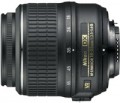Add to comparison |  |  |
|---|---|---|
| Nikon 18-55mm f/3.5-5.6G VR AF-S ED DX Nikkor | Nikon 18-55mm f/3.5-5.6G AF-S ED II DX Zoom-Nikkor | |
from $275.37 | from $78.00 up to $96.00 | |
| User reviews | ||
| TOP sellers | ||
| System | Nikon | Nikon |
| Mount | Nikon F | Nikon F |
Specs | ||
| Focal length | 18 - 55 mm | 18 - 55 mm |
| Aperture value | f/3.5 - f/5.6 | f/3.5 - f/5.6 |
| Viewing angles | 76° - 28°50' | 76° - 28°50' |
| Min. diaphragm | 22 | 22 |
| Minimum focus distance | 0.28 m | 0.28 m |
| Maximum zoom | 0.31 | 0.31 |
Design | ||
| Sensor size | APS-C | APS-C |
| Autofocus drive | ultrasonic drive motor | ultrasonic drive motor |
| Image stabilization | ||
| Design (elements/groups) | 11 elements in 8 groups | 7 elements in 5 groups |
| Number of diaphragm blades | 7 | 7 |
| Filter diameter | 52 mm | 52 mm |
| Dimensions (diameter/length) | 73x79.5 mm | 70.5x74 mm |
| Weight | 265 g | 205 g |
| Added to E-Catalog | december 2007 | november 2006 |